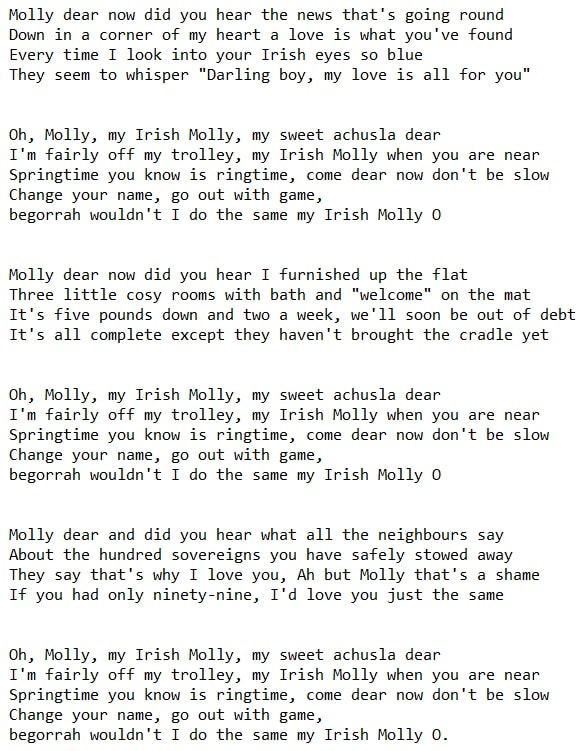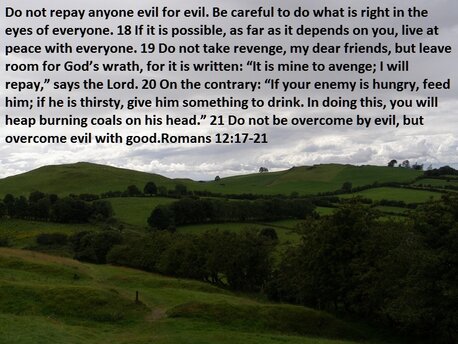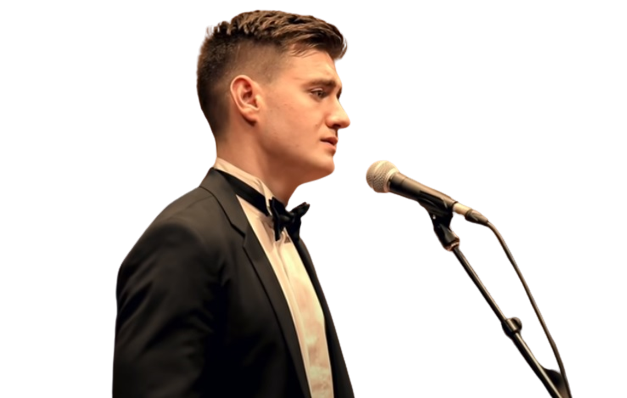My Irish Molly O Chords And Lyrics
Written by W.M Jerome with the music from Jean Schwartz 1905-Recorded by De Dannan And Maura O'Connell who also sang the Foster And Allen Song Maggie, also by Frank Patterson, The Dublin City Ramblers, Mary Duff, Emmet Cahill and Kathy Durkin. The guitar chords are in chordpro.
My Irish Molly Words And Chords In The Key Of C Major
[Am]Molly dear now did you hear the [C]news that's[G] going [Am]round
Down in a corner of my heart a love is [C]what you've [G]found
[Am]Every time I look into your [C]Irish [G]eyes so [Am]blue
They seem to whisper "Darling boy, my [C]love is [G]all for [Am]you"
[G]Oh, [C]Molly, my Irish Molly, my sweet achusla [Dm]dear
I'm [E7]fairly off my [Am]trolley, my Irish [Dm]Molly when you are [G]near
[C]Springtime you know is [G]ringtime, come dear now don't be [E]slow
[Am]Change your name, go out with game,
begorrah wouldn't I do the same [C]my Irish [G]Molly [C]O
Molly dear now did you hear I furnished up the flat
Three little cosy rooms with bath and "welcome" on the mat
It's five pounds down and two a week, we'll soon be out of debt
It's all complete except they haven't brought the cradle yet
Oh, Molly, my Irish Molly, my sweet achusla dear
I'm fairly off my trolley, my Irish Molly when you are near
Springtime you know is ringtime, come dear now don't be slow
Change your name, go out with game,
begorrah wouldn't I do the same my Irish Molly O
Molly dear and did you hear what all the neighbours say
About the hundred sovereigns you have safely stowed away
They say that's why I love you, Ah but Molly that's a shame
If you had only ninety-nine, I'd love you just the same
Oh, Molly, my Irish Molly, my sweet achusla dear
I'm fairly off my trolley, my Irish Molly when you are near
Springtime you know is ringtime, come dear now don't be slow
Change your name, go out with game,
begorrah wouldn't I do the same my Irish Molly O.
Other popular Irish songs about the name Molly include the most famous
Dublin song Molly Malone which is known the world over.
Lyrics And Chords K - M
[Am]Molly dear now did you hear the [C]news that's[G] going [Am]round
Down in a corner of my heart a love is [C]what you've [G]found
[Am]Every time I look into your [C]Irish [G]eyes so [Am]blue
They seem to whisper "Darling boy, my [C]love is [G]all for [Am]you"
[G]Oh, [C]Molly, my Irish Molly, my sweet achusla [Dm]dear
I'm [E7]fairly off my [Am]trolley, my Irish [Dm]Molly when you are [G]near
[C]Springtime you know is [G]ringtime, come dear now don't be [E]slow
[Am]Change your name, go out with game,
begorrah wouldn't I do the same [C]my Irish [G]Molly [C]O
Molly dear now did you hear I furnished up the flat
Three little cosy rooms with bath and "welcome" on the mat
It's five pounds down and two a week, we'll soon be out of debt
It's all complete except they haven't brought the cradle yet
Oh, Molly, my Irish Molly, my sweet achusla dear
I'm fairly off my trolley, my Irish Molly when you are near
Springtime you know is ringtime, come dear now don't be slow
Change your name, go out with game,
begorrah wouldn't I do the same my Irish Molly O
Molly dear and did you hear what all the neighbours say
About the hundred sovereigns you have safely stowed away
They say that's why I love you, Ah but Molly that's a shame
If you had only ninety-nine, I'd love you just the same
Oh, Molly, my Irish Molly, my sweet achusla dear
I'm fairly off my trolley, my Irish Molly when you are near
Springtime you know is ringtime, come dear now don't be slow
Change your name, go out with game,
begorrah wouldn't I do the same my Irish Molly O.
Other popular Irish songs about the name Molly include the most famous
Dublin song Molly Malone which is known the world over.
Lyrics And Chords K - M
Alternative guitar chords
[Bm]Molly dear now did you hear the [D]news that's[A] going [Bm]round
Down in a corner of my heart a love is [D]what you've [A]found
[Bm]Every time I look into your [D]Irish [A]eyes so [Bm]blue
They seem to whisper "Darling boy, my [D]love is [A]all for [Bm]you"
[A]Oh, [D]Molly, my Irish Molly, my sweet achusla [Em]dear
I'm [F#7]fairly off my [Bm]trolley, my Irish [Em]Molly when you are [A]near
[D]Springtime you know is [A]ringtime, come dear now don't be [F#]slow
[Bm]Change your name, go out with game,
begorrah wouldn't I do the same [D]my Irish [A]Molly [D]O
[Bm]Molly dear now did you hear the [D]news that's[A] going [Bm]round
Down in a corner of my heart a love is [D]what you've [A]found
[Bm]Every time I look into your [D]Irish [A]eyes so [Bm]blue
They seem to whisper "Darling boy, my [D]love is [A]all for [Bm]you"
[A]Oh, [D]Molly, my Irish Molly, my sweet achusla [Em]dear
I'm [F#7]fairly off my [Bm]trolley, my Irish [Em]Molly when you are [A]near
[D]Springtime you know is [A]ringtime, come dear now don't be [F#]slow
[Bm]Change your name, go out with game,
begorrah wouldn't I do the same [D]my Irish [A]Molly [D]O



